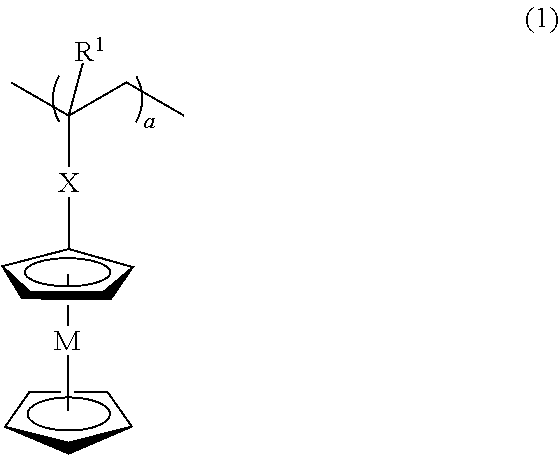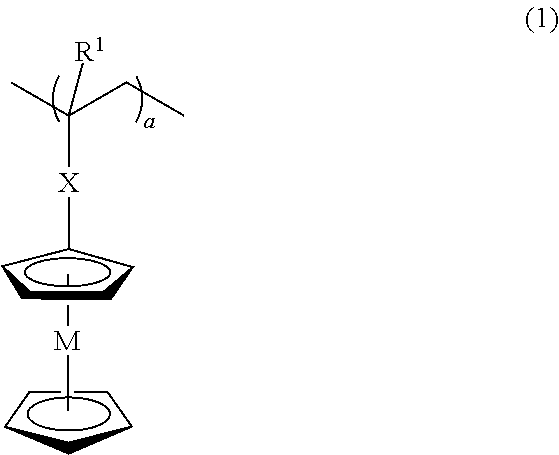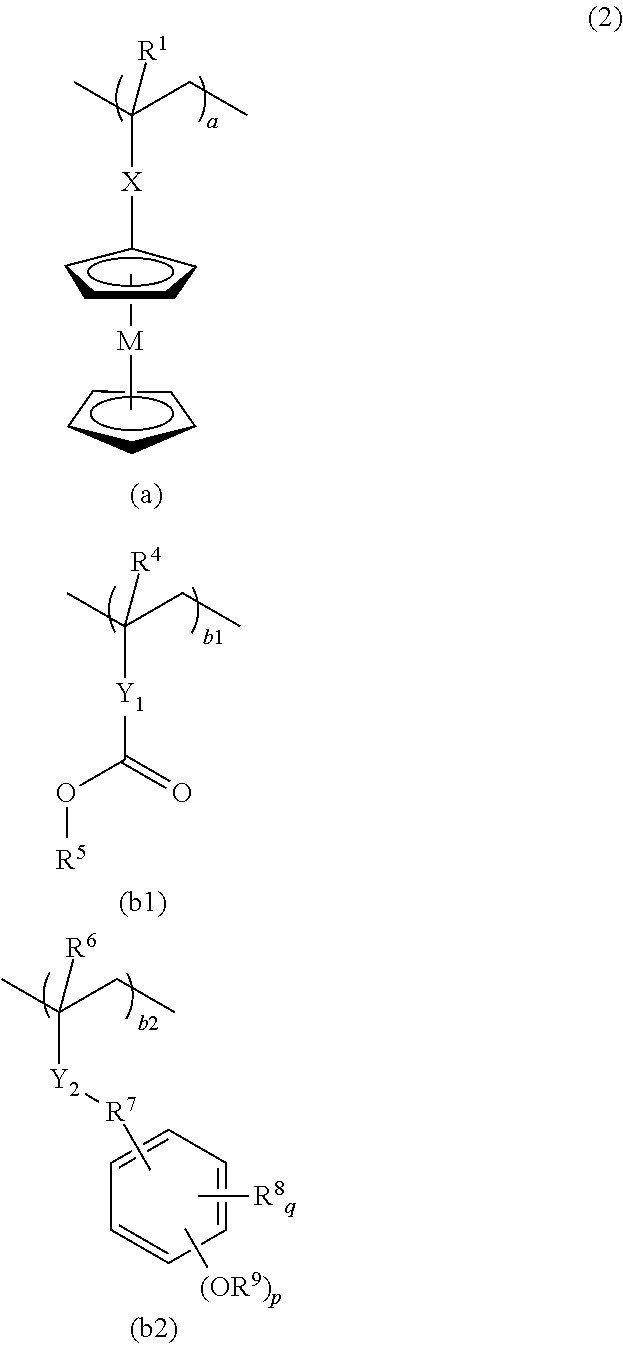Positive resist composition and patterning process using same
a technology of resist film and composition, applied in the field of positive resist composition, can solve the problems of deterioration in the sensitivity of the resist film, decrease in the productivity, and unsuitability, and achieve the effects of enhancing resolution, suppressing acid diffusion rate in the resist film, and enhancing sensitivity
- Summary
- Abstract
- Description
- Claims
- Application Information
AI Technical Summary
Benefits of technology
Problems solved by technology
Method used
Image
Examples
synthesis example 1
[0184]Into a 2-L flask were taken 5.5 g of 3-ethyl-3-exotetracyclo[4.4.0.12,5.17,10]dodecanyl methacrylate, 2.1 g of vinyl ferrocene, 11.4 g of 4-acetoxy styrene, and 40 g of tetrahydrofuran as a solvent. After this reactor was cooled under the nitrogen atmosphere to −70° C., this was degassed under vacuum and then blown by the nitrogen gas; this operation was repeated for three times. After the temperature was raised to room temperature, 1.2 g of AIBN (azobisisobutyronitrile) was added thereinto as the polymerization initiator; and then, after the temperature of the resulting mixture was raised to 60° C., the reaction was carried out for 15 hours. After this reaction solution was poured into 1-L of isopropyl alcohol for precipitation, the obtained white solid was dissolved again into the mixed solvent of 100 mL of methanol and 200 mL of tetrahydrofuran; and then, the deprotection reaction of the acetyl group was carried out at 70° C. for 5 hours with the addition of 10 g of triethy...
synthesis example 2
[0187]Into a 2-L flask were taken 5.7 g of 4-amyloxy styrene, 2.6 g of vinyl ruthenocene, 10.5 g of 4-acetoxy styrene, and 40 g of tetrahydrofuran as a solvent. After this reactor was cooled under the nitrogen atmosphere to −70° C., this was degassed under vacuum and then blown by the nitrogen gas; this operation was repeated for three times. After the temperature was raised to room temperature, 1.2 g of AIBN (azobisisobutyronitrile) was added thereinto as the polymerization initiator; and then, after the temperature of the resulting mixture was raised to 60° C., the reaction was carried out for 15 hours. After this reaction solution was poured into 1-L of isopropyl alcohol for precipitation, the obtained white solid was dissolved again into the mixed solvent of 100 mL of methanol and 200 mL of tetrahydrofuran; and then, the deprotection reaction of the acetyl group was carried out at 70° C. for 5 hours with the addition of 10 g of triethylamine and 10 g of water. After the reaction...
synthesis example 3
[0190]Into a 2-L flask were taken 5.1 g of t-butyl styrene-4-carboxylate, 3.2 g of vinyl ferrocene, 10.5 g of 4-acetoxy styrene, and 40 g of tetrahydrofuran as a solvent. After this reactor was cooled under the nitrogen atmosphere to −70° C., this was degassed under vacuum and then blown by the nitrogen gas; this operation was repeated for three times. After the temperature was raised to room temperature, 1.2 g of AIBN (azobisisobutyronitrile) was added thereinto as the polymerization initiator; and then, after the temperature of the resulting mixture was raised to 60° C., the reaction was carried out for 15 hours. After this reaction solution was poured into 1-L of isopropyl alcohol for precipitation, the obtained white solid was dissolved again into the mixed solvent of 100 mL of methanol and 200 mL of tetrahydrofuran; and then, the deprotection reaction of the acetyl group was carried out at 70° C. for 5 hours with the addition of 10 g of triethylamine and 10 g of water. After th...
PUM
| Property | Measurement | Unit |
|---|---|---|
| wavelength | aaaaa | aaaaa |
| wavelength | aaaaa | aaaaa |
| wavelength | aaaaa | aaaaa |
Abstract
Description
Claims
Application Information
 Login to View More
Login to View More - R&D
- Intellectual Property
- Life Sciences
- Materials
- Tech Scout
- Unparalleled Data Quality
- Higher Quality Content
- 60% Fewer Hallucinations
Browse by: Latest US Patents, China's latest patents, Technical Efficacy Thesaurus, Application Domain, Technology Topic, Popular Technical Reports.
© 2025 PatSnap. All rights reserved.Legal|Privacy policy|Modern Slavery Act Transparency Statement|Sitemap|About US| Contact US: help@patsnap.com



